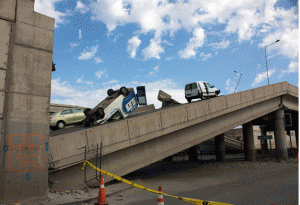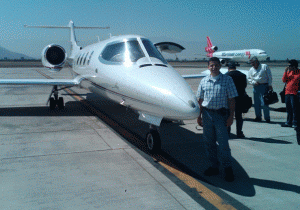This week, I’ve combined my blog and International Travel Tip into one topic. I hope you enjoy it.
Let’s say you are leading a multi-national project team in a foreign country, and a massive natural disaster strikes. Are you ready?
On Saturday, February 27, 2010, I was asleep in the Santiago Marriott. As a leader of a large EMC Consulting systems integration project team with members from Chile, Mexico, Brazil and the USA, I was in the middle weekend of a two week in-country rotation.
At 3:34 am, I was shaken out of my bed on the 22nd floor by the 3rd largest earthquake in recorded history – an 8.8 magnitude temblor lasting 3 minutes. Significant aftershocks occurred for weeks afterwards. Over 500 people were killed and over 9% of the country’s population lost their homes.
This blog provides some of my insights into what to do beforehand, what do to do during such a disaster, and (more importantly) what not to do.

PRIOR TO THE EVENT
The basics for personnel safety. As part of on-boarding new team members, obtain copies of their passports, contact information for themselves and family in country. In addition, obtain contact information for family that are not in country. Contact information includes personal as well as corporate wireless phones, hotels, apartments, as well as alternate numbers and emails.
Carry spare batteries for your cell phone and computer. Keep them fully charged. Even the Marriott generators went down periodically.
Pack a small flashlight. At various times, electricity would go out in the hotel, including one time while I was hiking the 22 floors back up to my room (All elevators were inoperative until safety checks were performed). The light from your smart phone works in a pinch, but a flashlight is best.
Always travel with comfortable shoes. For me, these are a pair of running shoes, which made the 22-floor ‘stair-master’ a relatively easy exercise.
Prepare a disaster recovery plan. In Chile, after we evacuated the team, we quickly implemented plans to relocate the development team to the EMC office in Sao Paulo, where EMC maintains a lab with servers and storage. We had the advantage of already being in touch with this lab due to delays in shipments of development environments to Chile prior to the earthquake. Activating the alternate development environment in Brazil was easy due to prior planning.

DURING AND IMMEDIATELY FOLLOWING THE EVENT
Account for your team members. Reach out to verify status (physical and emotional) of team members and family. Use prepared contact lists (see below), and dispatch other management team members in taxis to living quarters, if it is safe to do so. Be sure you account for your entire team.
Focus on safety of project team members and family. Immediately after the earthquake, although Santiago was not badly damaged, apartment units where various project team members and family were staying had lost electricity and water. I immediately relocated team members and family to the Santiago Marriott, which had sufficient backup power, food and water. Be sure to help local resources to check on their families throughout the country.
Make no sudden moves. If your project team sees you as anxious and flustered, it will spread to them. Methodically yet rapidly seek input, weigh options and then act. Yet, don’t automatically choose action over inaction. Throughout the days after the quake, I was bombarded by suggestions, including hiring a bus and driving from Santiago over the Andes to Mendoza, Argentina and then trying to fly to Buenos Aries. This could have jeopardized the team even further, as road conditions were unknown and flight options from Mendoza to Buenos Aires were few and frequently canceled. In the end, we waited and planned a simple and straightforward evacuation approach.
Brief corporate management of status as soon as practical, and then at least daily thereafter. It was urgent to provide accurate team status to corporate, including the fact that all team members were accounted for and safe.
Continue to monitor emotional status of team members and family. Be sure you open up and share your own feelings to your team, and ask how they feel. Some will be frustrated by the isolation from family; others may provide non-verbal signals. Be open with status of evacuation plans.
After five days, the Santiago airport reopened to limited flights (mostly national flights with very few international carriers). Our client arranged for a chartered Learjet to fly the international team members to Buenos Aires. I arrived home 7 days after the quake and was reunited with my family. After approximately 4 weeks of off-site work, we returned to Santiago.

For My Next Blog: Customer Data Quality – How to measure it, improve it and make improvements stick.
I hope you will join me and will pass on the link to your friends and networks. Please … subscribe, send me feedback, and check back for the next installment.
If nothing else, I promise the International Travel tips will be extremely useful!